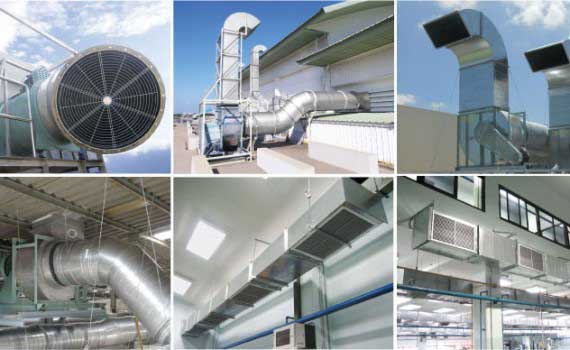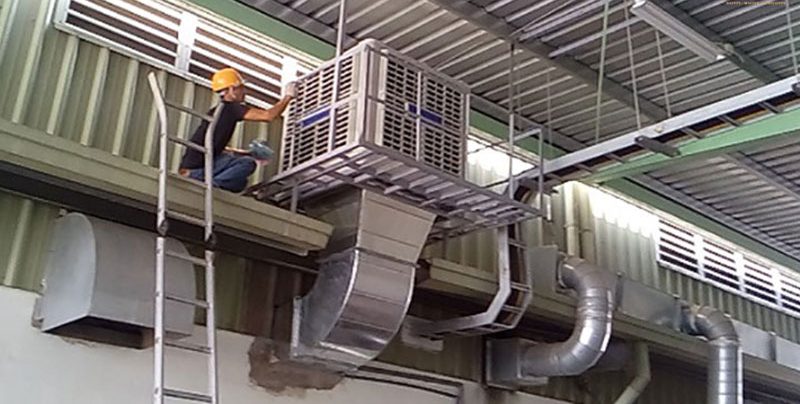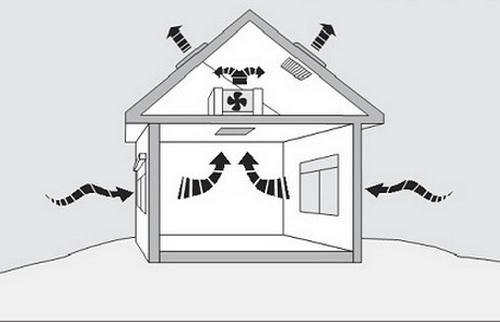You want to refer to how to install wall-mounted, wall-mounted, industrial ventilation fans for closed bedrooms with or without air conditioning? Or install ventilation fans for kitchens, bathrooms…. Exhaust fan (also known as exhaust fan) does what? Why should you install ventilation fans in tight spaces such as bedrooms or crowded workspaces? Read this article to better understand the exhaust fan installation that you can do yourself.
Why should we install exhaust fans?
Why should we install exhaust fans? To answer the above question, please read the content below

1. Chemical substances commonly found in apartments:
- Detergent from cleaning times
- The smell of paint and solvents
- The smell of formaldehyde from household items, carpets, construction materials.
- Pesticide.
- Light organic compounds.
- The musty smell after the rain or seeps into the background wall.
2. The necessity of using exhaust fans for ventilation
- Maintain fresh oxygen: Exhale polluted air.
- Deodorization: Eliminate unpleasant odors in the toilet, detergents…
- Remove dust and polluted air sources: In the air there are compounds such as: Light organic substances, allergens that affect the human body. Therefore, ventilation fans are essential to remove these substances.
- Absorb moisture: Steam is present everywhere in the house arising from the bathroom, boiled water, sweat on the human body…. Causes mold on the floor, wall surface, making the apartment quickly deteriorate.
Distinguish current popular exhaust fans and ventilation fans:
Before the instructions on how to install the exhaust fan, the company P69 helps you distinguish two types of wall-mounted and ceiling-mounted exhaust fans (exhaust fans).
1. Ceiling exhaust fan (exhaust fan):
Ceiling fans have the effect of balancing humidity, reducing heat in closed spaces, making the air fresher and more airy without affecting human activities.
When installing a ceiling fan, it can only be mounted on the ceiling with plaster or made from Cemboard material…
2. Exhaust fan (exhaust fan) wall mounted:
A wall-mounted ventilator is a device that helps circulate air from the outside to the inside.
The stagnant air will be brought outside instead of fresher air.
When mounting the fan on the wall, the wall of the house needs to meet the following two requirements: the wall is not too thick and there must be a space behind the fan mounting position.
3. Industrial exhaust fan (exhaust fan):
The industrial exhaust fans are designed with large blades, have high operating capacity, are durable and continuous.
Therefore, industrial exhaust fans are used in factories, workshops, industrial parks, basements…
4. Axial industrial exhaust fan (exhaust fan):
Axial industrial exhaust fans are designed with an axial shape, when the wind is sucked and blown to the outside parallel to the axial direction of the fan. Widely used in livestock areas, sucking away odors in basements…
5. Industrial ventilation fan (exhaust fan) with legs:
Has a relatively different design than the ventilation fans mentioned above. The fan has extra brackets and wheels, which is great for moving anywhere you want. Fans are commonly used in factories, mines, and high-rise buildings.
Instructions on how to install a wall-mounted exhaust fan (exhaust fan):
To own an exhaust fan that works best with the highest productivity with the most durable life. Special attention should be paid to and strictly complying with technical standards for each stage of construction as follows:
Step 1: Choose the appropriate exhaust fan capacity.
- First, you need to determine the volume of your bathroom to choose an exhaust fan with the right capacity.
- In order to ensure the performance of the fan and avoid wasting electricity when buying a ventilation fan with too much capacity for a room with a price that is too small.
- If the room is large but the capacity is small, the fan will have to operate beyond the allowable capacity, causing the fan to easily heat up and catch fire, reducing the life of the fan.
Step 2: Choose a fan with a suitable noise level.
- On all exhaust fan models, there are comments on noise level parameters, you can look carefully to choose for yourself a quiet fan, suitable for the operating space.
- Consider whether the noise level of the exhaust fan you choose affects your working or living space.
- This is also quite important for you to distinguish the characteristic fan noise or the noise caused by damage.
Step 4: Choose a suitable installation location.
- Choosing the location to install the ventilation fan for the installation space is an important thing.
- It greatly affects the performance and life of the fan.
- Fans need to be installed at central points of the installation space to increase ventilation.
- Depending on the size of the installation space, you can install one or more exhaust fans with suitable positions.
Step 5: Prepare full tools for installation.
- Preparing full tools before starting to install will help you save more effort, save time and think highly.
- Some basic tools that need to be prepared are: screwdriver, combination pliers, electric drill and jigsaw.
- Other materials you will need include: a flexible length conduit, a pine cap, screws, plugs and wire beads, protective gear such as goggles and a mask to wear while drilling.
Step 6: Determine the installation location.
- Use a small drill to make a mark on your wall or ceiling where you plan to install the exhaust fan. The right drill bit size will make it easier for you to install.
- It is necessary to carefully refer to the documentation to consider the location where the exhaust fan needs to be placed so that it is suitable and provides the best operating efficiency.
- Measure the intake port of the exhaust fan. Use a frame square and pencil to mark the outline of the fan’s intake port on the ceiling to cut holes in the ceiling for the installation location.
Step 7: Proceed to cut the loss of the port.
- First use a jigsaw or a reciprocating saw or drywall saw to cut out the porthole in the ceiling you marked above.
- Cut evenly and gently to match the marked line. Do not let the cut parts of the ceiling fall to the floor after cutting.
- It is necessary to use protective gear at least a mask and glasses when performing this step to protect your eyes and lungs.
Step 8: Install the exhaust fan in place.
- First need to cut, attach a 90 degree elbow pipe to the appropriate outlet port and use foil tape to secure it in place.
- Insert a cable connection through the hole and directly remove on the side. Then slide the metal support bracket into place.
- Proceed to place the fan in the correct position to install so that the center of the exhaust fan must go through the ceiling hole. Make sure all connection points are oriented correctly.
Step 9: Firmly fix the exhaust fan.
- To ensure that the exhaust fan is securely and securely attached, it is necessary to widen each metal frame until it can firmly hold in place. Use solid wall screws to secure each end of the frame to the beams.
- Next take the length of the flexible duct and attach one end to the 90 degree elbow protruding from the ceiling.
Step 10: Connect the power lead for the exhaust fan.
- Run the power cable for the exhaust fan. Protect the power cable safely with a strong protective cover. Use a three-wire cable if your new exhaust fan includes lighting.
- Take the power line for the exhaust fan in the shortest, straightest and most convenient way. For ease of installation and repair. As well as helping to increase the aesthetics of the area.
- Proceed to run the holes through the hips or roof, so that it is most convenient. This helps to discharge the exhaust fan to the outside, helping to ventilate the space in the best way.
Step 11: Attach the vent cover for the exhaust fan.
This process is performed depending on whether the exit point is on the roof or on the side wall. Specifically:
- If the exit point is on the side wall: then select a point between two wall studs with a reference measure on the inside, that is, position the top point on the same outside. Use a 4-inch saw hole to cut through the wall from the outside, then secure the pine cover in place.
- If the exit point is on the roof: draw a circle of the appropriate size inside and use a reciprocating saw to cut it out. Then thread through the roof (taking all appropriate safety precautions). Place the pine cap in place and secure it with the recommended items.
- Proceed to attach the ends of the duct tape to the pine cap joint using foil tape.
Step 12. Install the remaining stages.
- Depending on the type of fan, the appropriate electrical connection wire can be selected.
- Get information from the manufacturer through the user manual. To have the right choice of power cable. (Strip 5/8 inch (1.6 cm) back from each wire on both fan and power cables).
- Open the vent cover and pull the power cord away from the exhaust fan from the soldering unit.
- Proceed to twist wires of the same color together (usually white to white and black or red to black) and add connections. Wrap bare copper wire around green clamp ground or screw and tighten to secure.
- Put the wires back in the soldering unit and reinstall the cover.
- Finally proceed to attach the grille for the exhaust fan. The decorative plastic grille for the wall exhaust fan can be installed by sliding its mounting cord into an available slot in the housing. It should be ensured that it is securely fixed and in accordance with the specifications.
- Connect the power to the exhaust fan to check if the fan is working properly and there are no defects. For timely remedial and repair.
Instructions on how to install ventilation fans – industrial exhaust fans
Industrial ventilation fans are one of the optimal solutions to help bring fresh air to large rooms. Thereby improving efficiency, labor productivity and work.
With these characteristics, industrial ventilation fans are popularly used in large room spaces, where many people gather, especially companies, factories, offices, etc.

Industrial ventilation fan installation process:
Industrial ventilation fans are usually installed according to the following installation procedure:
– Step 1: First, you need to determine the exact location to install the exhaust fan to bring the best performance. Also helps to determine the size and design suitable for the space where the industrial ventilation fan is installed for the most accurate.
– Step 2: Next determine the size of the exhaust fan including: length, width, height. To create the most appropriate and moderate space suitable for ventilation fans.
– Step 3: Cut the frame to place the ventilation fan on the roof, or the wall with the dimensions specified above.
– Step 4: Install the exhaust fan in the specified position.
– Step 5: Conduct wiring for the exhaust fan. A separate switch for the fan can be installed or the fan can be connected to a power source using the fan’s power cord. All designs are designed to improve the use quality and life of the exhaust fan.
Instructions on how to install a ceiling fan exhaust fan :
Normally, the installation of ceiling fans will only take about 30 minutes to 1 hour to complete. However, this time can also be shortened or extended depending on factors: power source or space for installation.
Procedure for installing ceiling fan (exhaust fan):
Because the ceiling fan works on a fairly simple principle, it can only be installed through a few technical steps as follows:
– Step 1: Equip the most necessary and basic knowledge source.
– Step 2: Prepare all necessary tools before installation. The tools needed to prepare are the same as when installing other types of ventilation fans.
– Step 3: Disconnect all connections to the power source for safety.
– Step 4: Measure the size of the fan from the length, width to the height of the fan to get the size of the ceiling fan.
– Step 5: Use a drill and a specialized cutter to create a space in the ceiling that fits the specified ventilation fan size.
– Step 6: Install the exhaust fan parts on the ceiling in turn according to the manufacturer’s instructions, and fix the parts firmly with nails and screws.
– Step 7: Finally, connect the fan’s electrical wire to the power source so that the electrical path is the shortest and most convenient.
Instructions on how to install exhaust fans – exhaust fans for air-conditioned rooms

- In an air-conditioned room, it is usually a closed space and needs good air circulation to ensure an adequate supply of oxygen.
- In addition, the place where the air conditioner is combined with the ventilation fan will help circulate fresh air and limit mold, because bacteria accumulate high due to high humidity.
- Helps create a convection flow that circulates air inside and outside the house, your air will be changed, providing more fresh air from outside.
- This combination limits many diseases for humans related to the respiratory tract and skin due to high humidity, mold and bacteria do not have the conditions to grow. …
- Commonly used in office buildings, factories, etc. to increase work productivity and maintain long-term health.
- In addition, it also helps to improve the working quality of the air conditioner. Reducing odors in the room from here will help the air conditioner reduce the capacity burden, increase the durability of the air conditioner and save electricity…
- The installation procedure of the exhaust fan for the air conditioner is similar to that of the installation in a well-ventilated room mentioned above.
Price list for installing ventilation fans you can refer to:
The following unit price is for labor only and does not include materials. You can refer to the following price list, the unit price may fluctuate more or less.
| Content | Unit | Unit price |
| Install an exhaust fan that already has a hole in the wall | Female |
100,000 VND – 200,000 VND
|
| Install an exhaust fan without a hole in the wall, do not go through a duct | Female |
300,000 VND – 500,000 VND
|
| Install ceiling fan in plasterboard | Female |
200,000 VND – 300,000 VND
|
| Install exhaust fan with duct | Female | From 500,000 VND |
| Install industrial exhaust fan | Female |
Survey and quote later
|
The above article guides you in detail on how to install the most basic exhaust fan, do you know how to install it yourself?
Contact us today for a free consultation and answer at:
Contact information P69 – M&E . M&E Contractor
Address: No. 6/165C Xuan Thuy, Cau Giay District, Hanoi
Website: https://p69.com.vn/
Hotline: 02437688156 – 0965937799
Email: kd@cokhip69.com.vn
Facebook: https://www.facebook.com/p69nhathaucodien
LinkedIn: https://www.linkedin.com/in/congtyp69/
Youtube : https://www.youtube.com/channel/UCOUwCnE5iGj8iqe_ZIUM7oA

